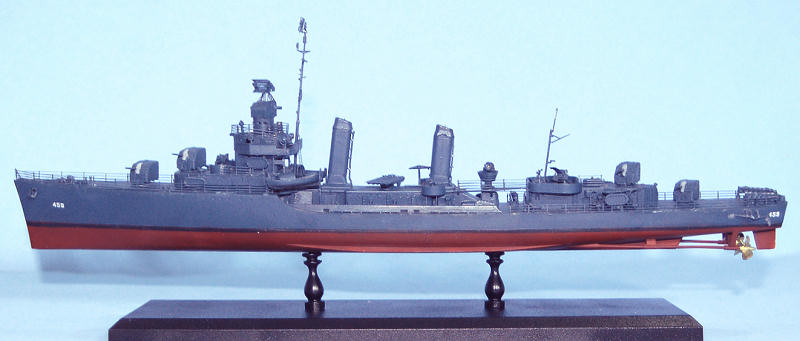
| KIT #: | 10262 |
| PRICE: |
3,900 yen at
HobbyLink |
| DECALS: | One option |
| REVIEWER: | Tom Cleaver |
| NOTES: |

| HISTORY |
My favorite ships are destroyers. Their very name - “destroyer” -
beats the emotional daylights out of “fighter,” “bomber,” or “battleship.” I
have always been a fan of World War II American destroyers. To me, they are
the “fighter planes” of ships.
So far as I am concerned, there is nothing more pugnacious than a
Fletcher, Sumner or Gearing class American destroyer.
My time in the Navy included the final years of these great ships,
and I always got a rush to see them coming in and out of harbor, or doing
unreps with the old USS “Rustbucket” off the coast of South Vietnam
on Operation Market Time operations, though I knew that with my
proclivity for sea-sickness, I would never be a “tin can sailor” (I got
seasick going aboard to see a buddy on his Gearing DD that was tied
up to the mole in Hong Kong).
While I love the flush-deck Fletchers, Sumners and Gearings,
to me the most elegant American destroyer is the fo’c’sle-deck Benson
class. Did you know that in the
movie “On The Town” (1949), Gene Kelly and Frank Sinatra leave a
Benson-class DD that’s still in measure 5 camouflage on the way to their
24 hours in
In 1958, I got my parents to cut loose of the incredible sum of $25
whole American dollars to get me the hardbound first edition of “History
of United States Destroyer Operations in World War II,” which is still
the definitive history, for my birthday.
The book is 24 inches by 18 inches by 3 inches thick - I still have
it, and have probably read it through 20 times, with time spent on
references to specific actions too many to number. It’s still the biggest
book in my library other than the Random House Unabridged Dictionary.
If you too are a Destroyer Fan, the original first edition is still
available from the US Naval Institute, for a price that is not much more
than I paid (with inflation factored in).
So far as I am concerned, there are no war stories more stirring than
those of the American destroyers that went toe-to-toe with Japanese
battleships and cruisers in the waters off Guadalcanal between August 1942
and February 1943, which is probably the bloodiest period in American naval
history.
USS “Laffey”:
USS “Laffey” (DD‑459) was laid down January 13, 1941 by
Bethlehem Shipbuilding Co. in
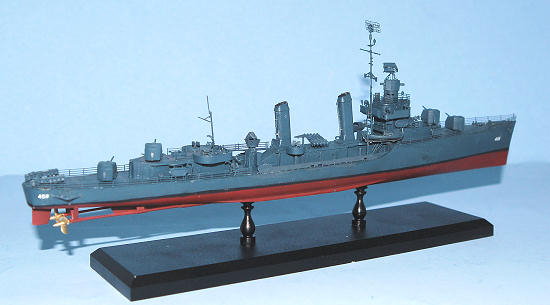 USS “Laffey” was commissioned
USS “Laffey” was commissioned
“Laffey” participated in her first fleet action in the
During the course of the next several weeks, the Japanese attempted
to destroy Henderson Field, as a preliminary to landing major reinforcements
on the island to drive the Americans off.
Three days after the battle off
The battle for the island was reaching its peak.
For the Japanese, it was “do or die,” while the Americans were
hanging on by the skin of their teeth.
“A Bar-Room Brawl After
The Lights Were Shot
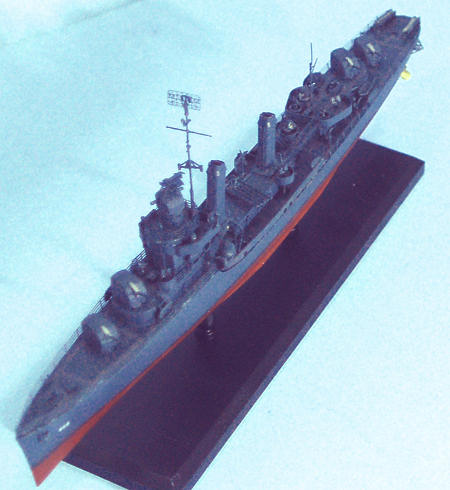 Out”
Out”
If the
Knowing that the Japanese planned a major assault in November to
retake Guadalcanal, Task Force 67 - a large reinforcement and resupply
convoy commanded by RADM Richmond K. Turner - arrived in “Ironbottom Sound”
on November 11. The supply ships were protected by two task groups,
commanded by RADM Daniel J. Callaghan and RADM Norman Scott, with cover by
aircraft from Henderson Field. The convoy was attacked twice on
November 11 by Japanese aircraft based at Bougainville.
Overnight, most ships were unloaded, but the convoy would not be able
to complete unloading before the evening of November 13.
Throughout the day of November 13, the fleet was at battle stations
as waves of Japanese airplanes swept in to attack.
That afternoon, the cruiser San Francisco and destroyer
Buchanan were both hit, with 30 deaths and 50 wounded.
In the two days the fleet was there, 12 Japanese aircraft were shot
down by anti-aircraft fire from the ships or by fighters from Henderson
Field.
Late that afternoon, ComSoPac warned of the sighting of a large
Japanese task force headed down the Slot, which would arrive that night.
RADM Turner combined his heavy surface forces into Task Group 67.4
under the command of RADM Daniel J. Callaghan.
This was unfortunate, since it was RADM Norman Scott who had been the
victor at the Battle of Cape Esperance in October and had the experience to
command such a fight as was foreseen.
However, Callaghan was senior in rank by two days, though
inexperienced in combat. Task
Group 67.4 was composed of Callaghan’s flagship the heavy cruiser San
Francisco with Portland, the light cruisers Helena, Atlanta,
and Juneau (which was Scott’s flagship), covered by the
destroyers Aaron Ward, Barton, Cushing, Fletcher, Laffey, Monssen,
O'Bannon, and Sterett.
Allied intelligence knew this was the opening move of the major
Japanese operation to retake Guadalcanal.
If Henderson was knocked out this time, they might just do it. Task
Group 67.4 was ordered to stop the Japanese at all costs.
The oncoming Japanese force was centered around Battleship Division
11, with the battleships Hiei and Kirishima, supported by the
light cruiser Nagara, and the destroyers Inazuma, Ikazuchi,
and Akatsuki, under the command of VADM Hiroshi Abe.
Following behind Abe’s force was a Japanese con voy carrying 7,000
troops of the 38th Division, which were to be landed on
Guadalcanal the morning of November 14, following the successful
neutralization of Henderson Field.
voy carrying 7,000
troops of the 38th Division, which were to be landed on
Guadalcanal the morning of November 14, following the successful
neutralization of Henderson Field.
The night of November 12/13 was perfect for what the Japanese
planned, being the dark of the moon with rain squalls in all quadrants.
Unfortunately, the inexperienced Callaghan put the two ships of the task
group with the newest SG radar - Helena and Fletcher - at the
rear of the formation. The oldest destroyers led the formation, while San
Francisco led Portland, followed by Norman Scott’s two
anti-aircraft light cruisers, Juneau and Atlanta; all were
equipped with the temperamental SC radar.
At 0124, US radar picked up the Japanese fleet. At 0130, Callaghan's
force intercepted Abe's bombardment group between Guadalcanal and Savo
Island.
Callaghan ordered a turn north to cross the Japanese “T” as Scott had
done at Cape Esperance. Both
formations stumbled into rain squalls, which kept Callaghan from being
certain of his fleet’s positions when Cushing confirmed the radar
contacts as Japanese.
Cushing requested permission to open fire, but Callaghan delayed due to
uncertainty.
Suddenly both formations emerged from the squalls, with Admiral Abe
surprised to find an unexpected American fleet practically within point
blank range.
Fortunately for the Americans, the Japanese were even less prepared
for a surface engagement. Their
mission was to shell Henderson Field, and thus the battleships were armed
with HE shells full of sub-munitions, rather than the AP, while the ships
were not in battle formation.
Unfortunately for the Americans, the thirteen Japanese destroyers were all
armed with the Long Lance torpedo and all the Japanese ships were
better-versed in night fighting than were the Americans.
Almost all the American losses in the battle would come from this
weapon.
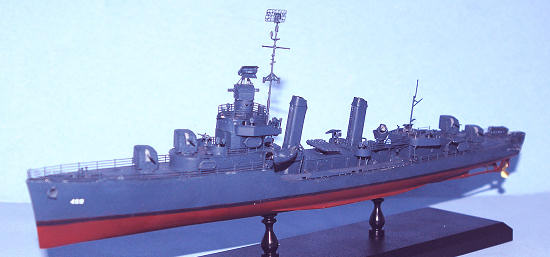 The Japanese illuminated the Americans with searchlights that were
quickly shot out. Realizing his
force was nearly surrounded by the Japanese, Callaghan ordered, "Odd ships
fire to starboard, even ships fire to port."
The Japanese illuminated the Americans with searchlights that were
quickly shot out. Realizing his
force was nearly surrounded by the Japanese, Callaghan ordered, "Odd ships
fire to starboard, even ships fire to port."
What happened next was described by one of the surviving officers on
Monssen as "a barroom brawl after the lights had been shot out".
Laffey passed 20 feet to starboard of Hiei, narrowly
missing collision. The Japanese battleship couldn’t depress her batteries
low enough to hit Laffey, while the destroyer raked Hiei’s
superstructure with 5-inch and machine gun fire, damaging Hiei’s
bridge, wounding Admiral Abe, and killing his chief of staff, which cut off
the leadership of the Japanese force.
“Laffey” also fired all five of her torpedoes at “Hiei”,
though without effect. With “Hiei”
on her port beam and “Kirishima” coming up on her starboard beam, “Laffey”
used her five 20mm and 1.1 mount to shoot out the Japanese searchlights, to
escape into the darkness.
Sterett
and O'Bannon also hit Hiei from close range. San Francisco
then passed 2,500 yards away and Hiei, along with Kirishima,
Inazuma, and Ikazuchi concentrated their fire on San
Francisco. In a matter of minutes, San Francisco took 15 major
shell hits and 25 lesser, disabling her steering and killing Admiral
Callaghan, Captain Cassin Young, and most of the bridge staff. Fortunately,
the first salvos from Hiei and Kirishima were the special
fragmentation bombardment shells, which have saved San Francisco
being sunk outright.
As all this was happening, “Laffey” passed out of range of “Hiei”
and engaged four Japanese destroyers at point-blank range.
A sudden barrage of 14-inch shells from “Hiei” swamped the crippled “Laffey”
just as a Long-Lance torpedo fired by one
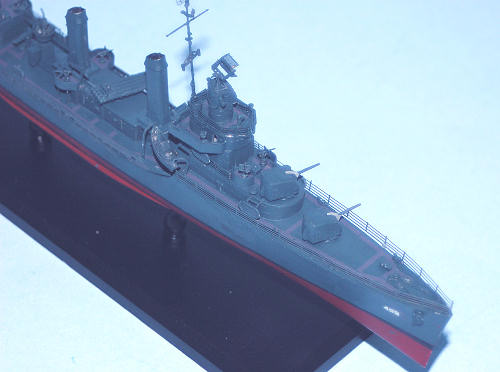 the Japanese destroyer “Teruzuki”
hit her just under her after 5-inch mounts.
As the order was passed to abandon ship was passed, a violent
explosion in her after magazine ripped “Laffey” apart and she sank
immediately, taking 59 of her crew down with their ship.
3 of her5 officers were killed and 8 were wounded, while 108 enlisted
crewmen were wounded.
the Japanese destroyer “Teruzuki”
hit her just under her after 5-inch mounts.
As the order was passed to abandon ship was passed, a violent
explosion in her after magazine ripped “Laffey” apart and she sank
immediately, taking 59 of her crew down with their ship.
3 of her5 officers were killed and 8 were wounded, while 108 enlisted
crewmen were wounded.
In the resulting melée, Abe's warships sunk or severely damaged all
but one cruiser and one destroyer in Callaghan's force and both Callaghan
and Scott were killed. Two Japanese destroyers were sunk and another
destroyer and “Hiei” heavily damaged. In spite of his defeat of
Callaghan's force, Abe ordered his warships to retire without bombarding
Henderson Field. “Hiei” sank later that day after repeated air
attacks by CAF aircraft and aircraft from the U.S. carrier “Enterprise.”
USS “Laffey” was awarded the Presidential Unit Citation for
her gallant performance in the battle.
In 1992, the forward portion of USS “Laffey” was discovered by
Robert Ballard, resting upright on the floor of Ironbottom Sound in 2,600ft
of water, her bow guns still trained to port where they had last fired at
the “Hiei” during the violent night battle which sank her.
In April 2006, the cruise ship “Clipper Odyssey” came to a
stop over the position of Laffey. Mrs. Cary Webb Sears, daughter of LCDR
Hank, addressed the passengers and crew before leading a wreath ceremony.
A second USS “Laffey,” DD 724, was also awarded a Presidential Unit Citation for action off Okinawa when attacked and hit by kamikazes while on radar picket duty; her story is told in the book “The Ship That Couldn’t Sink.” The Sumner‑class destroyer USS “Hank,” DD 702, was named for LCDR Hank.
| THE KIT |
USS “Laffey” is the second “Benson”-class DD released by Dragon, the first being USS “Buchanan.” Dragon provides different detail parts, including a different forward superstructure and different stacks, so that a modeler could make any of the “Bensons” with suitable reference material, though the after 1.1 inch “pom-pom” would need to be replaced on those ships serving from 1943 onwards. The kit is beautifully molded with a wealth of very small detail. As is usual, the hull comes in upper and lower halves, and has very good fit. Some photoetch detail is provided, but the modeler will have to obtain aftermarket sets (which have been released by both White Ensign Models and Gold Medal Models) for such things as rails, radar antennas, etc. For more on the kit itself, visit the preview.
| CONSTRUCTION |
For me, construction starts with the hull, since it has been my
experience that being able to work both inside and outside on that
attachment ensures the best fit. I
followed that by attaching the deck.
| COLORS & MARKINGS |
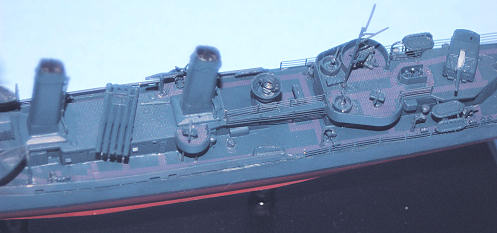 Since “Laffey” was painted in overall Measure 5 Dark Sea Blue, I
didn’t have to pre-paint parts in different colors, and could proceed
directly to assembly of the superstructure.
Dragon’s instructions are clear, and I followed them.
For this model, I closed up all the hatches.
Once I had the main superstructure complete, I proceeded to paint the
model, starting with Hull Red, then masking for the black divider, and
finishing with a color mixed to a paint chip for the Dark Sea Blue.
I also painted all the small parts on their sprues, and the left-over
photo-etch I would be using for railings and radar.
Since “Laffey” was painted in overall Measure 5 Dark Sea Blue, I
didn’t have to pre-paint parts in different colors, and could proceed
directly to assembly of the superstructure.
Dragon’s instructions are clear, and I followed them.
For this model, I closed up all the hatches.
Once I had the main superstructure complete, I proceeded to paint the
model, starting with Hull Red, then masking for the black divider, and
finishing with a color mixed to a paint chip for the Dark Sea Blue.
I also painted all the small parts on their sprues, and the left-over
photo-etch I would be using for railings and radar.
Before proceeding further, I applied the walkway decals, and the hull
numbers, which went down easily under a coat of Micro-Sol.
| FINAL CONSTRUCTION |
As noted above, the kit has a wealth of tiny detail.
I am glad that Dragon supplies an extra for each of these smaller
parts, since one is bound to make at least one sacrifice to the carpet
monster through the process.
For me, I started on the upper decks and worked my way to the lower decks,
attaching bits and pieces according to the instructions.
I found no problems - other than having to work under the magnifier
lamp so I could see everything, 1/350 scale being about as small as my eyes
can deal with nowadays.
I attached the armament aimed to port, the position they were in when
“Laffey” was last seen in this world as she attacked “Hiei” in
the Battle of Guadalcanal.
When all was attached, I proceeded to attach the photoetch railing. Fortunately, this isn’t on the scale of a “Hood” or “Prinz Eugen,” and the process was completed in bout 90 minutes. I then gave the model an overall coat of Xtracrylix Flat Varnish and attached the props, finishing off by attaching the model to the stand.
| CONCLUSIONS |
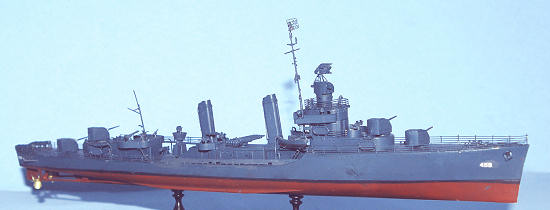 I have always liked the Bensons ever since seeing photos of them so
long ago when I first opened that big book, “History of U.S. Destroyer
Operations.” Dragon’s kit
doesn’t disappoint for creating a delicate yet purposeful little ship, one
that in the case of USS “Laffey” came equipped with a very big heart
indeed. The model is
recommended to anyone who has had experience of building a ship model.
I have always liked the Bensons ever since seeing photos of them so
long ago when I first opened that big book, “History of U.S. Destroyer
Operations.” Dragon’s kit
doesn’t disappoint for creating a delicate yet purposeful little ship, one
that in the case of USS “Laffey” came equipped with a very big heart
indeed. The model is
recommended to anyone who has had experience of building a ship model.
Thanks to HobbyLink
Japan for the review copy. Get
yours at www.hlj.com
October 2009
If you would like your product reviewed fairly and quickly, please contact me or see other details in the Note to Contributors.